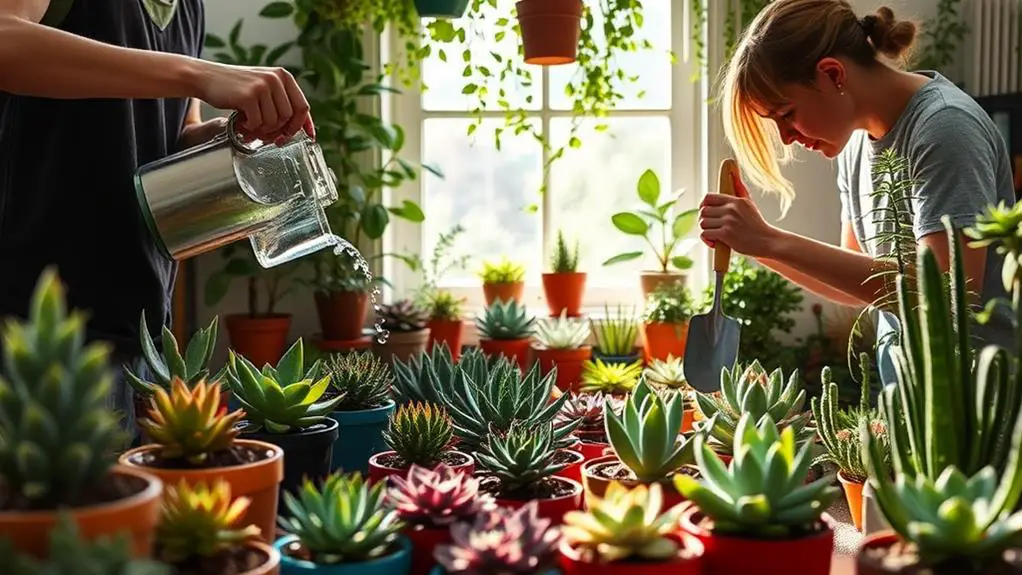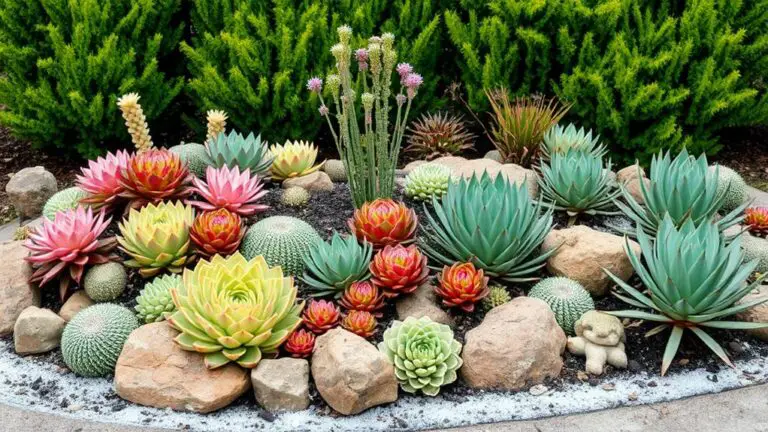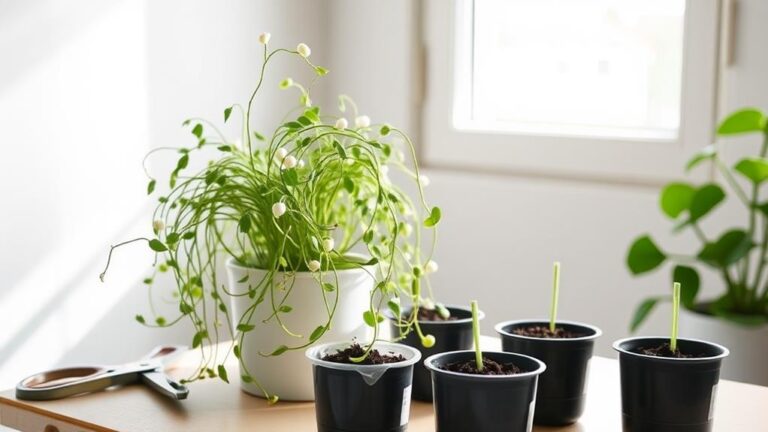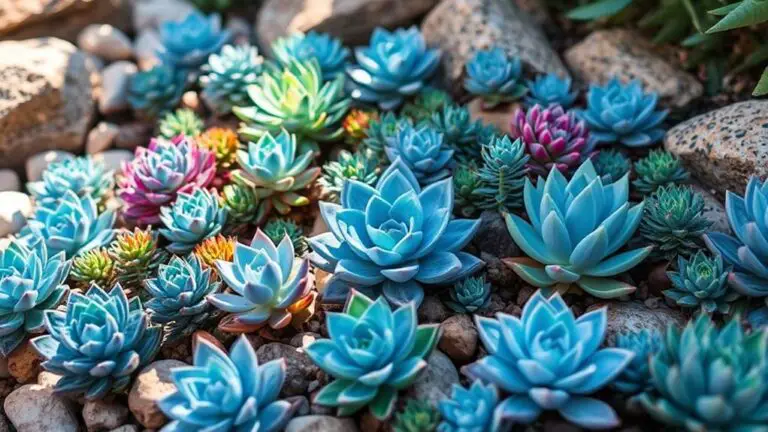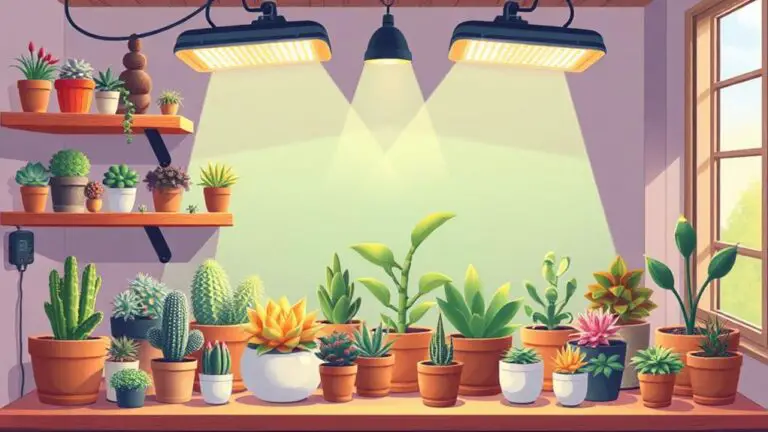10 Tips to Extend Your Succulents’ Lifespans
If you've ever struggled to keep your succulents alive, you're not alone. These hardy plants can be deceptively tricky to care for without the right knowledge. You might think succulents need minimal attention, but subtle missteps can shorten their lifespans. Interested in discovering how to give your succulents the care they deserve? From mastering watering techniques to choosing the right soil, these ten actionable tips will transform your approach to succulent care, ensuring your plants not only survive but thrive. Ready to reveal the secrets to healthier, longer-living succulents?
Understand Their Lifespan
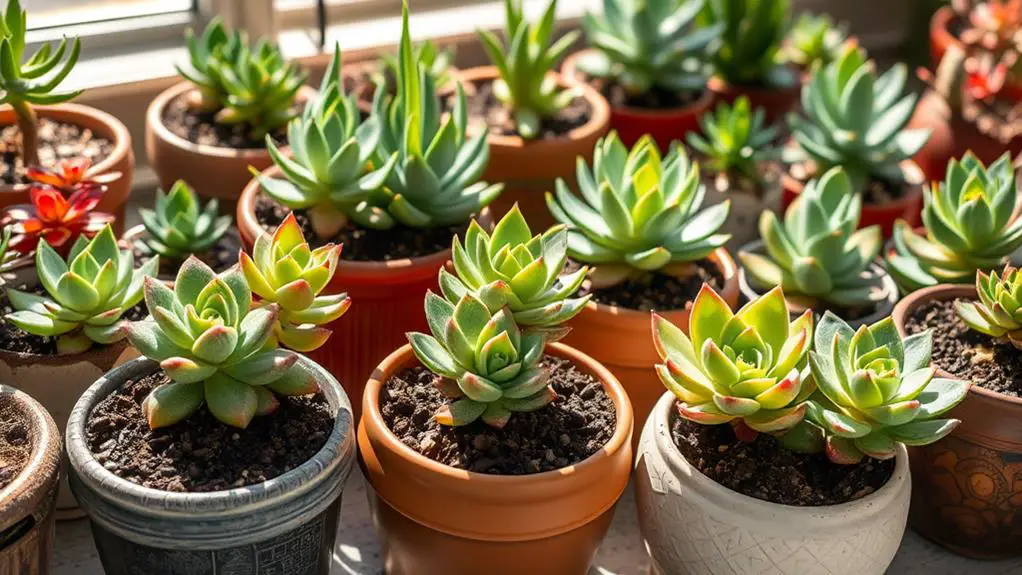
Understanding the lifespan of your succulents is essential for their care and longevity. Succulent lifespans can vary greatly depending on the species. For instance, Echeveria can last around 1-3 years, while a Jade plant might thrive for 70-100 years. Knowing this helps you provide the proper care each plant needs to reach its full potential.
Environmental factors play a significant role in how long your succulents live. Aim for bright, indirect sunlight, temperatures between 60-80°F, and low humidity. Indoor succulents often enjoy longer lifespans due to more stable conditions. They're not exposed to harsh weather or herbivores that can harm them.
Proper care is key. Use well-draining soil to prevent root rot and make sure your pots have drainage holes. Regularly monitoring for pests can stop issues before they start. Pests like mealybugs can quickly damage your plants if left unchecked.
Some succulents, like Agave and Sempervivum, are monocarpic. They flower once and then die. Understanding these reproductive habits helps you know what to expect and how to handle it.
With the right care, your succulents can thrive and brighten your space for years.
Proper Watering Techniques

When it comes to watering your succulents, the "soak and dry" method is key.
Make sure you thoroughly soak the soil until water drains out the bottom, then wait until the soil is completely dry before watering again.
Don't forget to adjust your watering schedule as seasons change, watering less in winter and more during spring and summer.
Soak and Dry Method
The soak and dry method is an important technique for keeping your succulents healthy and vibrant. When you water your succulent, thoroughly soak the soil until water drains from the bottom of the pot. This guarantees the entire root system is hydrated, which helps prevent root rot.
It's important to allow the soil to dry completely before watering again. Depending on factors like temperature and humidity, this can take anywhere from 1 to 3 weeks.
Succulents prefer infrequent, deep watering over shallow, frequent watering. This encourages strong root development and makes the plant more resilient. To check if it's time to water, stick your finger about an inch into the soil. If it feels dry, then it's time to water again.
Using a pot with drainage holes is vital for the soak and dry method. These holes let excess water escape, which reduces the risk of overwatering. Consistent watering using this method helps your succulent thrive.
Seasonal Watering Adjustments
During different times of the year, your succulent's watering needs will change. In the growing season, usually spring and summer, you should water your succulents more frequently.
However, as autumn and winter roll around, you'll need to reduce water frequency to prevent over-saturation during their dormancy.
To make sure your succulents thrive, consider these tips:
- Seasonal changes: Adjust your watering schedule based on the time of year. More water in warmer months, less in cooler ones.
- Soil moisture: Always check the soil before watering. Only water when it's completely dry to a depth of at least one inch.
- Soak and dry method: Thoroughly saturate the soil until water drains from the bottom, then let it dry out completely before watering again.
- Environmental factors: Monitor temperature and humidity. In warmer, drier conditions, you might need to water more often, while cooler, more humid environments require less frequent watering.
- Pot size: Smaller pots dry out faster and may need more frequent watering, while larger pots with good drainage retain moisture longer.
Avoid Overwatering Risks
Overwatering is one of the most common mistakes succulent owners make, but you can easily avoid it by employing proper watering techniques. First, only water your succulents when the soil is completely dry. This usually means every 1-3 weeks, depending on environmental conditions and pot size. A well-draining soil mix, containing coarse sand and perlite, helps prevent water retention and root rot.
Use the soak and dry method for proper watering. Thoroughly water the plant until water drains from the bottom, ensuring no excess moisture remains in the pot. This technique mimics natural rainfall and prevents overwatering.
Always keep an eye on your succulents for signs of overwatering, like yellowing leaves or mushy stems. These symptoms indicate it's time to adjust your watering routine.
During the growing season, succulents need more water, but they require less during the dormant season. Remember to reduce watering frequency when they aren't actively growing.
Additionally, make sure your succulents receive adequate sunlight, as it helps the soil dry out faster and keeps the plants healthy. By following these tips, you'll extend your succulents' lifespans and keep them thriving.
Use Well-Draining Soil
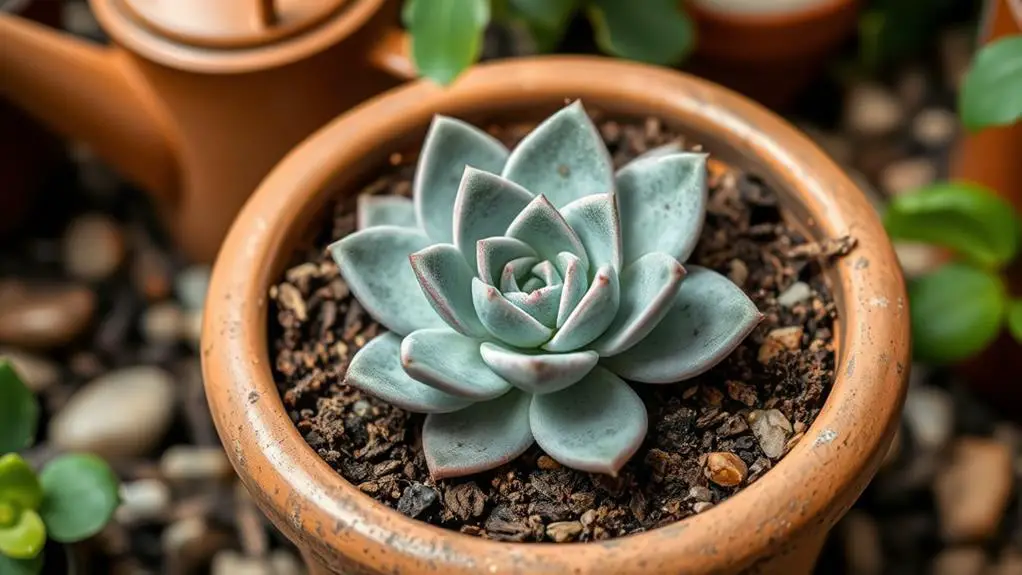
One essential aspect of succulent care is using well-draining soil. Succulents are prone to root rot, so it's important to provide them with the right kind of soil. A good mix combines potting soil with coarse sand and perlite. This helps the soil drain quickly, preventing excess moisture from harming your plants.
Specialized cactus or succulent soil is also great because it retains minimal moisture while allowing air to reach the roots.
Here are some tips to keep your succulents happy:
- Mix your own soil: Combine potting soil, coarse sand, and perlite.
- Inspect regularly: Check the soil texture often. If it's compacted or too wet, consider repotting.
- Avoid garden soil: Regular garden soil is too dense and holds too much moisture.
- Check soil pH: Aim for a pH between 6.0 and 7.0 for ideal nutrient availability.
- Use specialized soil: Cactus or succulent soil is designed to support healthy succulent growth.
Provide Adequate Sunlight
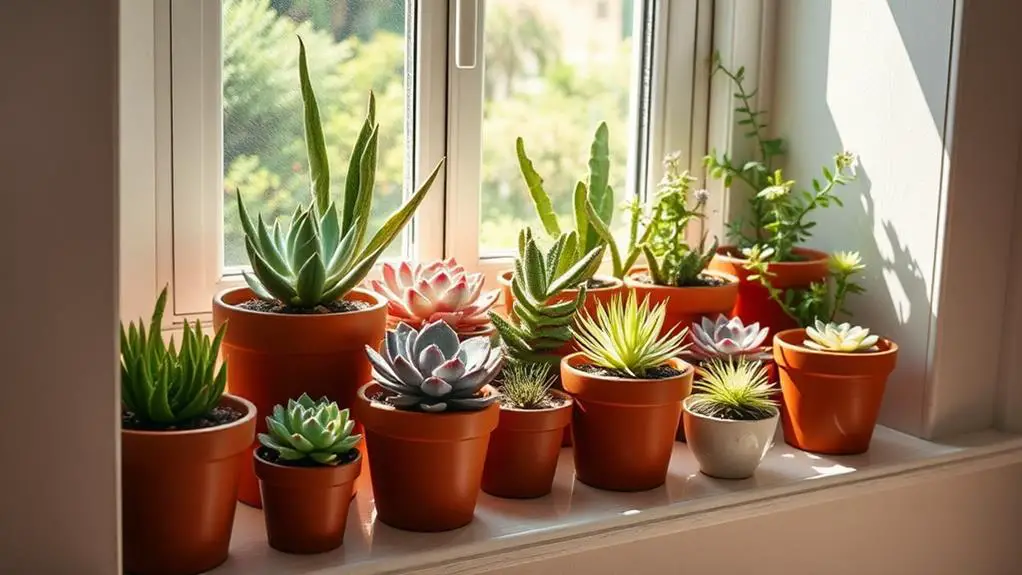
To keep your succulents happy, they need bright, indirect sunlight for about 6 hours each day.
Place them near a south or west-facing window to give them the best light.
If natural light is limited, especially in winter, consider using artificial lighting to help them thrive.
Optimal Light Conditions
When it comes to succulent care, providing adequate sunlight is essential for guaranteeing their health and vibrancy. Most succulents thrive in bright indirect sunlight, needing around 6 hours of light each day. This helps them grow strong and maintain their lovely colors.
However, giving your succulents the ideal light conditions isn't always straightforward.
Here are some key tips to keep in mind:
- Bright Indirect Sunlight: Place your succulents near windows where they can soak up lots of light without being scorched.
- Monitor Light Exposure: Keep an eye on your plants. If they're stretching or turning pale, they mightn't be getting enough light.
- Artificial Lighting: During darker months or for indoor plants, consider using LED grow lights to provide adequate light.
- Species-Specific Needs: Remember, different succulents have unique preferences. For instance, Aloe vera loves bright light, while some Echeveria varieties do better with a bit more shade.
- Rotate Regularly: Turn your pots every few weeks to guarantee all sides get even light.
Avoid Direct Sunlight
Most succulents need bright, indirect light for ideal growth, but exposing them to direct sunlight can cause sunburn and dehydration, damaging their health. To keep your succulents happy, place them where they get about six hours of filtered sunlight daily. This helps them thrive without risking overexposure.
If you're growing succulents indoors, east or west-facing windows are perfect spots. They offer morning or late afternoon light while avoiding the harsh midday sun.
When you move your succulents outdoors, it's important to acclimate them slowly. Gradually increase their sunlight exposure over a week to prevent shock and sunburn on their leaves.
Using sheer curtains or shade cloths can help filter sunlight, protecting your succulents from intense rays. These simple tools guarantee your plants get the right amount of light without the risk of damage.
Use Artificial Lighting
Sometimes natural light just isn't enough, especially if you're keeping your succulents indoors or in a low-light area. Succulents need bright, indirect light to thrive, and that's where artificial lights come in handy.
Using LED grow lights can supplement the sunlight your plants receive, providing the full spectrum of light necessary for photosynthesis.
To get the best results, position your artificial lights 6 to 12 inches above the succulents. Keep them on for 12 to 16 hours a day to guarantee they get sufficient light without overheating or burning the leaves.
Here are some tips to help you use artificial lighting effectively:
- Choose LED grow lights: They're energy-efficient and mimic sunlight well.
- Use timers: This helps maintain a consistent light cycle, preventing stress from light fluctuations.
- Monitor for light deficiency: Look out for leggy growth or pale leaves and adjust the light accordingly.
- Guarantee proper distance: Keep lights 6 to 12 inches above the plants.
- Adjust duration: Depending on your setup, anywhere from 12 to 16 hours of light might be needed.
Maintain Optimal Temperature
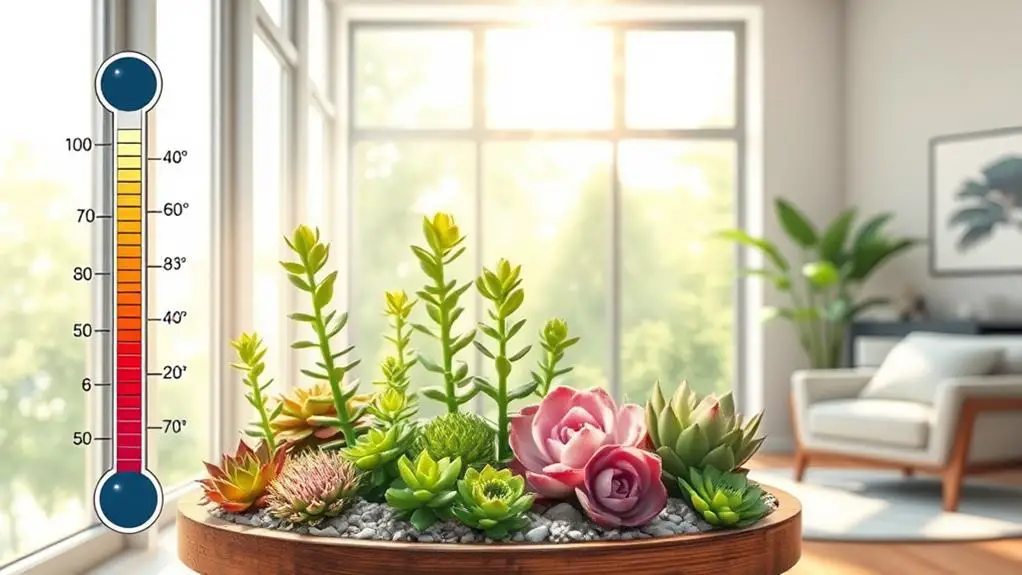
Keeping your succulents at the right temperature is essential for their health and growth. Most succulents thrive in temperatures ranging from 60°F to 80°F (15°C to 27°C). Maintaining this range provides an ideal environment for growing and guarantees their longevity.
Sudden temperature changes can stress your plants, so it's important to acclimate them gradually when moving them between indoor and outdoor spaces.
In hot climates, succulents can suffer from sunburn and dehydration if exposed to extreme heat. Provide shade during the hottest parts of the day to protect them. Using a simple shade cloth or placing them in a spot with indirect sunlight can help.
On the flip side, many succulents are sensitive to cold and can be damaged by temperatures below 32°F (0°C). If you live in a colder area, make sure to bring your succulents indoors or use frost cloths to shield them from freezing temperatures.
A thermometer can be a handy tool to monitor the temperature where your succulents are growing. This way, you can confirm they remain in their perfect environment, helping them to thrive and live longer, healthier lives.
Seasonal Care Adjustments
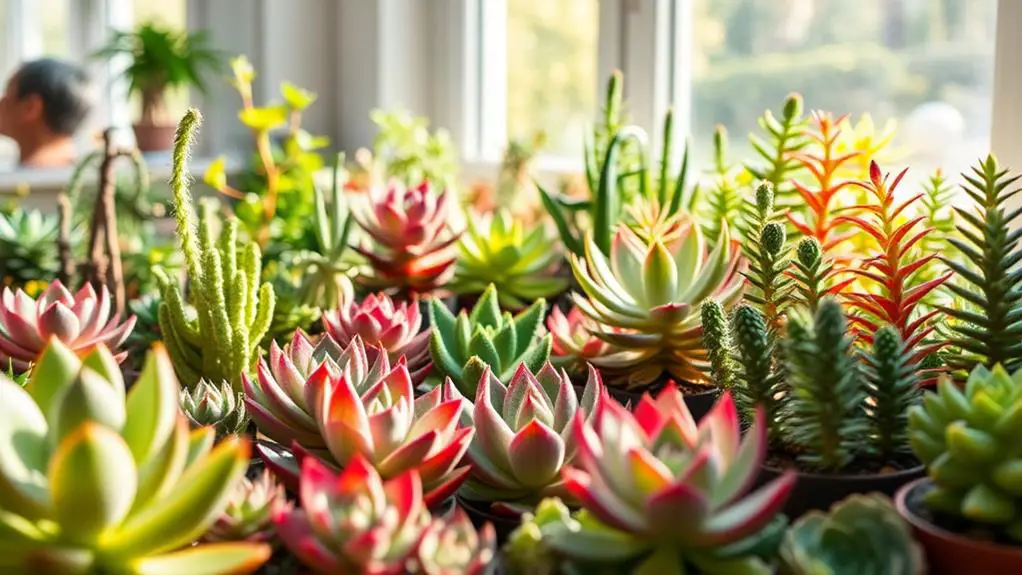
As the seasons change, you'll need to adjust your care routine to keep your succulents thriving.
During winter, reduce watering and keep an eye on temperature to protect them from frost.
Also, remember to cut back on fertilization since succulents generally enter dormancy during the colder months.
Winter Protection Strategies
Winter protection strategies are vital for guaranteeing your succulents thrive during the colder months. When temperatures drop, your succulents need extra care to stay healthy.
Begin by moving potted succulents indoors to protect them from frost. If you can't bring them inside, a miniature greenhouse or cloche can help keep them in their ideal temperature range of 60-80°F (15-27°C).
During the winter, it's important to adjust your watering schedule. Succulents enter dormancy, and overwatering can lead to root rot. Make certain the soil is completely dry before giving them any water.
Cover outdoor succulents with straw, burlap, or frost cloth to insulate them from frost while allowing airflow to prevent moisture buildup.
Regularly check your plants for signs of stress like wilting or discoloration, and adjust your care as needed to support their healthy growth.
Here are some tips to remember:
- Use miniature greenhouses or cloches to insulate from frost.
- Make certain the soil is completely dry before watering.
- Cover outdoor succulents with straw, burlap, or frost cloth.
- Move potted succulents indoors during extreme cold.
- Regularly check for signs of stress and adjust care practices.
Adjust Watering Frequency
Ensuring your succulents receive the right amount of water year-round is key to their health and growth. During the growing season, which spans spring and summer, you should water your succulents more frequently—about every 1-2 weeks.
Make sure the soil dries out completely between waterings to prevent root rot. This is essential for maintaining the right balance of moisture.
As fall and winter approach, you need to adjust your care routine. Succulents enter a dormant period and require less water, so reduce your watering frequency to every 3-4 weeks.
Their growth slows down, and too much moisture can cause overwatering issues like yellowing leaves or mushy stems.
Monitoring soil moisture is vital. Check the top 1-2 inches of soil; if it's dry, it's time to water. If it's still damp, wait a bit longer.
Environmental factors like humidity and temperature also play a role. Higher humidity might mean less frequent waterings to avoid excess moisture retention.
Seasonal Fertilization Tips
When caring for your succulents, seasonal fertilization plays an essential role in their health and vigor. During the growing season, which spans spring and summer, you'll want to apply a diluted, balanced fertilizer every 4-6 weeks. This supports robust growth and flowering.
However, as fall and winter approach, reduce or completely halt fertilization. Most succulents enter dormancy and don't need extra nutrients during this time.
To guarantee your succulents get balanced nutrients without the risk of over-fertilization, follow these tips:
- Use a fertilizer specifically formulated for cacti and succulents. These usually have lower nitrogen levels to prevent excessive leaf growth.
- Incorporate natural fertilizers, like crushed eggshells, to provide calcium and other nutrients, promoting healthy root development.
- Always follow the recommended dosage on the fertilizer packaging. Over-fertilization can lead to nutrient burn and harm your plants.
- Avoid chemical buildup by using natural fertilizers sparingly.
- Consistently monitor your succulents for signs of nutrient stress, adjusting your fertilization schedule as needed.
Pest and Disease Prevention
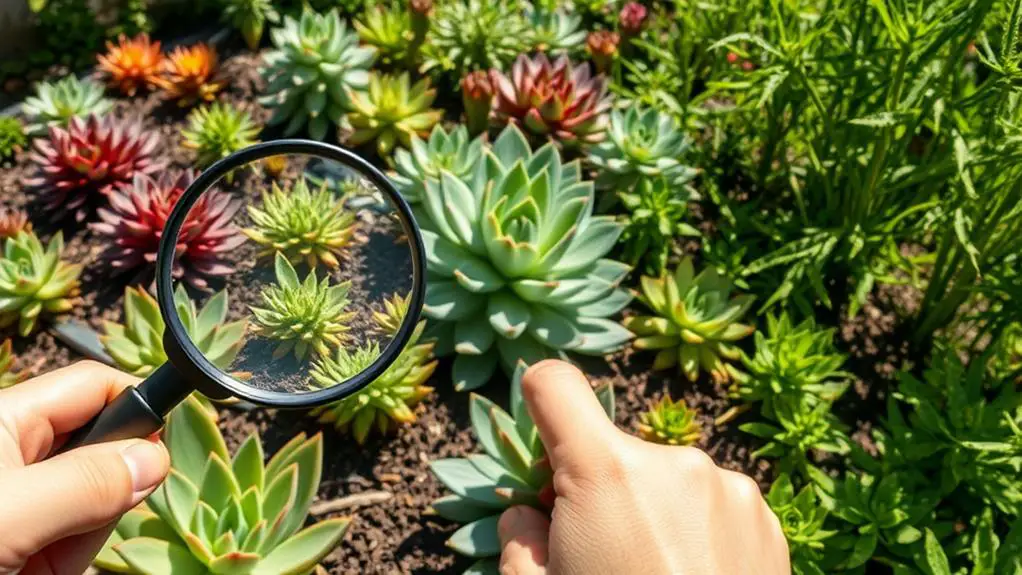
Vigilance is key when it comes to keeping your succulents healthy and pest-free. Regularly inspect your plants for pests and diseases, such as mealybugs and spider mites. Early detection is essential in preventing infestations that can weaken your succulents.
When you spot an issue, act quickly to isolate the affected plant. This helps prevent the problem from spreading to your other succulents.
Proper airflow is another important aspect of preventing diseases. Space your plants adequately to reduce humidity, which can lead to fungal infections. Ensuring good airflow helps your succulents stay dry and healthy.
Using well-draining soil is necessary for succulent care. It prevents moisture retention, which is a common cause of root rot and other problems. A high-quality soil mix designed for succulents will help keep your plants thriving.
Introducing beneficial insects, like ladybugs, to your garden can also be a great way to control pest populations naturally. They won't harm your succulents and are effective at keeping pests in check.
Repot When Necessary
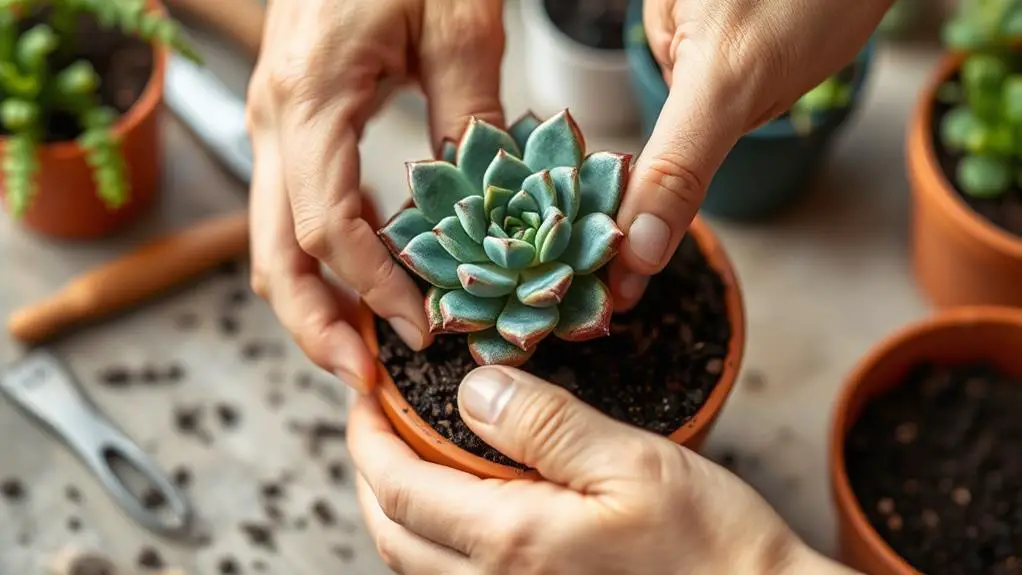
Repotting isn't just a chore; it's an essential part of succulent care that assures your plants have the space they need to thrive. Repot your succulents every 2-3 years or when you notice the roots becoming crowded. This helps assure healthy growth and prevents root suffocation.
Use a well-draining soil mixture, like a cactus potting mix combined with perlite. This promotes proper drainage and prevents root rot. When choosing a new pot, go for one that's only slightly larger than the current one. Too much excess soil can retain moisture, which succulents don't need.
Here's a quick checklist to help you when it's time to repot:
- Repot every 2-3 years or when roots are crowded.
- Use a well-draining soil, like cactus potting mix with perlite.
- Choose a pot just a bit larger than the old one.
- Water lightly after repotting to settle the soil.
- Monitor signs of stress, like wilting or discoloration.
After repotting, water the succulent lightly to help the soil settle. Resume regular watering once your plant has acclimated.
Keep an eye on your succulent for stress signs, such as wilting or discoloration, and adjust care practices to support its recovery. With these steps, your succulents will continue to flourish!
Prune and Groom Regularly

Regularly pruning and grooming your succulents is essential for maintaining their health and appearance. By removing dead or damaged leaves through pruning, you'll prevent the spread of disease and encourage healthier growth. This simple task can make a big difference.
Pruning during the active growing season—spring and summer—is best. Succulents recover quickly during this time, ensuring they thrive after a trim.
Grooming your succulents is just as important. Clean dust from their leaves to help them photosynthesize effectively. Clean leaves mean stronger, healthier plants. It's a simple task that can have a big impact on your succulent's well-being.
When pruning, always use sterilized tools. This is vital to avoid introducing harmful pathogens that could damage your plants. Sterilizing tools is easy—just wipe them with rubbing alcohol before you start.
Pruning can also stimulate new growth and encourage the production of offsets, especially in monocarpic succulents like Agave. These offsets can be propagated to extend the lifespan of your plants.
Monitor Plant Health

While pruning and grooming keep your succulents looking their best, monitoring their overall health guarantees long-term vigor. Regular checks can help you catch problems early, ensuring your plants thrive for years.
First, regularly inspect your succulents for signs of distress, such as wilting leaves or discoloration. These signs may indicate overwatering or insufficient light exposure. Catching these early helps you adjust your care routine before it's too late.
Next, check for pests like mealybugs and aphids weekly. Early detection allows for prompt treatment, preventing severe damage. Use a magnifying glass if needed to spot these tiny invaders.
Monitoring soil moisture levels is essential. Use the "snap-scratch test" to check if the soil is dry enough for watering. This helps prevent root rot by ensuring you only water when necessary.
Observe your succulents' growth patterns. A lack of new growth may signal environmental stress or nutrient deficiencies. Addressing these promptly keeps your plants healthy.
Finally, watch for signs of dormancy, such as slowed growth and leaf shedding. Adjust your care routine accordingly to support your plants during these periods.
- Inspect for distress signs
- Check for pests weekly
- Monitor soil moisture levels
- Observe growth patterns
- Adjust care during dormancy
Frequently Asked Questions
What Is the Trick to Keeping Succulents Alive?
You need to use well-draining soil, avoid over-watering, and let the soil dry between waterings. Place them in bright, indirect light, keep temperatures steady, and watch for pests. Lightly fertilize during the growing season.
How Many Years Can a Succulent Live?
Succulents' lifespans vary widely. Some, like Echeveria, live 1-3 years, while others, like Jade Plants, can thrive for 70-100 years. Your care, light, and temperature management greatly impact their longevity. Choose wisely for desired lifespan.
How Do You Bring Succulents Back to Life?
To bring succulents back to life, water thoroughly, trim mushy parts, and acclimate to indirect sunlight. Check for pests and treat promptly. Adjust care routines for dormant succulents by reducing watering and providing a cooler environment.
How Do You Fix Elongated Succulents?
To fix elongated succulents, move them to a brighter location, prune the elongated stems, and repot them in well-draining soil. Consistently water, allowing the soil to dry out completely between waterings, and consider using supplemental grow lights.
Conclusion
You've got all the tools you need to help your succulents thrive! By following these tips—like proper watering, using the right soil, and keeping an eye on pests—you'll guarantee your plants stay healthy and beautiful. Remember to adjust your care with the seasons and keep checking on your plants. With a bit of attention and love, your succulents can live a long, happy life. Happy gardening, and enjoy watching your plants grow!

